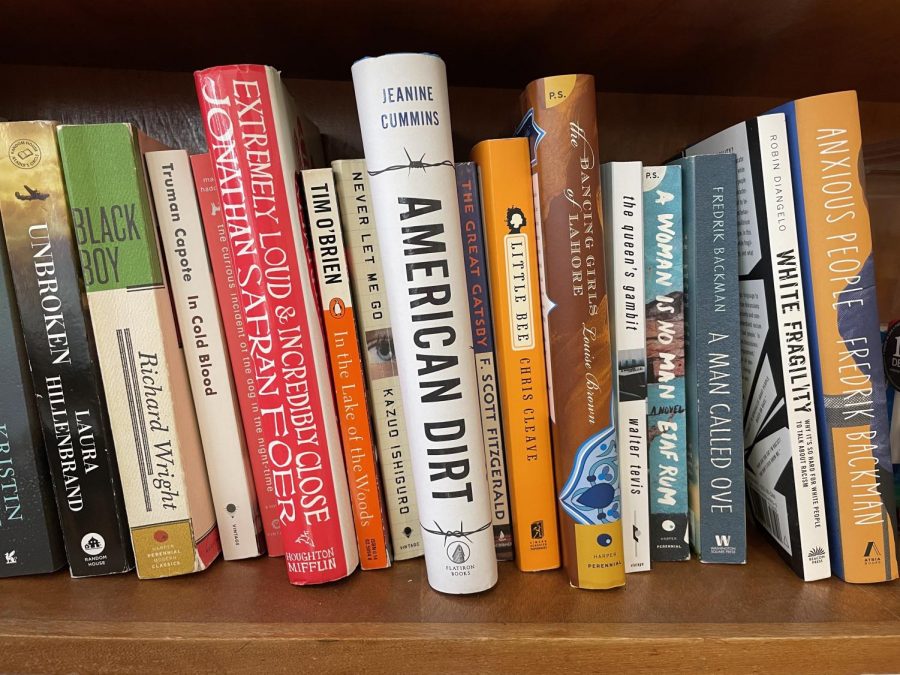All That Required Reading Isn’t Gold
The Push for Independent, Choice-Based Reading
March 1, 2021
It is universally acknowledged that every high school student must undergo their English department’s grueling required reading curriculum. Of course, this wasn’t always the case.
In the 1960’s and 70’s, students were allowed to read books of their choice every day for 15-30 minutes in a program called “Sustained Silent Reading.” Flash forward to the 21st century and, with the rise of Common Core standards and other systematic programs, required reading is a hallmark of any middle and high school’s English curriculum. Works by Shakespeare and other dead/old/white/men (feel free to circle all that apply), and titles like Lord of the Flies, are practically rites of passages. Supporters of required reading say that it offers teachers more control in the classroom in terms of streamlining discussions on plot and craft; others say that it’s still worth exploring issues that these works raise. These are valid arguments, and teachers are often limited in what they can do by state education regulations. However, aside from issues of diversity in the curriculum, educators should also be concerned with the effects of required reading on students’ attitudes towards reading.
Why is reading important, anyway? Reading teaches two foundational skills: thinking critically and writing well. These are skills that are carried throughout one’s life and are crucial for any workplace. Reading also teaches empathy, according to a study conducted at the University of Buffalo. Raymond Mar, a psychologist at York University, and Keith Oatley, a professor of cognitive psychology at the University of Toronto, discovered that those who read fiction seemed to better “understand other people, empathize with them and view the world from their perspective.” In other words, people who read are kinder, more open-minded people. These discoveries shouldn’t be surprising. Joyce Carol Oates, American novelist, playwright, and poet, said that “Reading is the sole means by which we slip, involuntarily, often helplessly, into another’s skin, another’s voice, another’s soul.” Anne Lamott, in her classic writing handbook, Bird by Bird, said that “Books help us understand who we are and how we are to behave. They show us what community and friendship mean; they show us how to live and die.”
Reading can also strengthen one’s health. Besides decreasing stress and improving memory, a study published in Neurology found that reading reduced the rate of cognitive decline in dementia patients. Meanwhile, Stanford neurologists and radiologists teamed up with English scholar Natalie Phillips, and they found that reading exercised underworked regions of the brain.
Unfortunately, in an anonymous survey of 95 students at South High, half of the participants said “No” to whether or not they enjoyed reading. What’s more alarming is that 51.6% agreed that their required reading books fueled their dislike of reading and only 13.1% disagreed. Half of the participants already disliked reading. Forcing required reading upon them was like rubbing salt in a wound. “The fact that I needed to sit there for weeks analyzing it or needing to annotate [it] detracted from my enjoyment of reading the book,” said Sarah Bernstein, a junior.
For books that students didn’t enjoy, 65.3% chose the explanation that “The plot was too boring and/or not interesting enough.” 32.6% chose “The book was not timely and/or applicable to my life.” 45.3% chose “The writing was too difficult to understand,” and 38.9% chose “It was difficult to understand the book’s significance that made it a ‘required reading’ book.”
These numbers reveal disappointing information, and though they may not be what English teachers want to hear, transparency and honesty are crucial in any step toward improvement.
One solution can be the implementation of independent reading, where students are given the choice to choose their own reading materials. According to a recent survey carried out by Scholastic Corp., a popular publisher of children’s books, middle and high school students who have time to read books of their own choosing are also more likely to read for fun. While many South High teachers encourage independent reading, this freedom, for the most part, is only given in the summer. However, independent reading doesn’t need to come at the cost of required reading; it’s not one or the other. The two can coexist and work side by side, and for the few teachers who encourage more independent reading during the academic year, the results have come back as overwhelmingly positive.
The teachers follow a similar model: students are assigned to read approximately 2–3 hours per week of a choice book. Each week they write a reflection in which they tell the teacher what they read, how long they read, and any other thoughts they want to share about the book and/or the reading process. This is in addition to reading core books.
In Mrs. Shaw’s ninth grade English class, there’s no genre-shaming when it comes to reading books that are “too Young Adult” or “too Middle Grade,” prompting kids to read books they’re actually interested in. The reading reflection is an honest, stereotype-breaking process, demonstrating that there’s no perfect reader. Some students admit they didn’t have the time to read that week because of, for example, three tests. Others say that they began reading a book and eventually abandoned it because of a lack of interest. But what’s important is that they’re being genuine; they’re not cheating or using SparkNotes as a shortcut. They’re processing words on a page, they’re using both sides of their brain—they’re putting in the hard work and effort.
Bernstein, who is doing independent reading in Ms. Hastings’ AP Language course, thinks this can benefit students. “It’s done a really good job of making me more excited to read,” she said.
Freshman Brian Dai added that “Being able to read for enjoyment, compared to academics, is a huge difference that can only be seen if you experience it.”
Student reflections reveal that they’re proud of themselves for reaching their weekly reading time. It’s especially encouraging to learn that certain students, who lost their enjoyment of reading in middle school, are regaining it. Jansen Wong, also a junior, said, “The one novel that finally pushed me to read more was Turtles All the Way Down by John Green because I really couldn’t put the book down, and it reminded me of my old love for reading and books.”
Poll numbers also support the openness towards independent reading by South High students. In the survey, 65.7% of participants would support the shift towards an independent, choice-based reading system, and a massive 74.7% said they’d be more inclined to read and take the initiative to find books of their own.
The teachers in the English department at South High who truly care about their students should not be solely concerned about preparing them for the English regents or AP’s. A top priority should be developing lifelong readers, even if it means giving students the reins to choose their own books.






